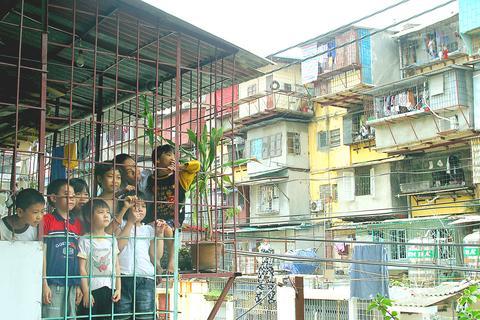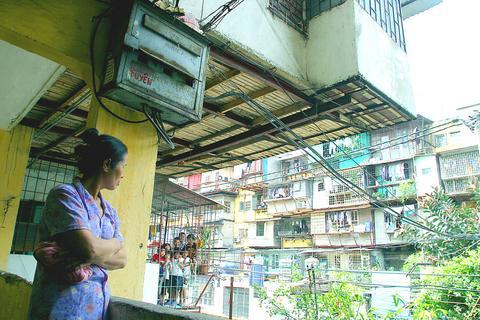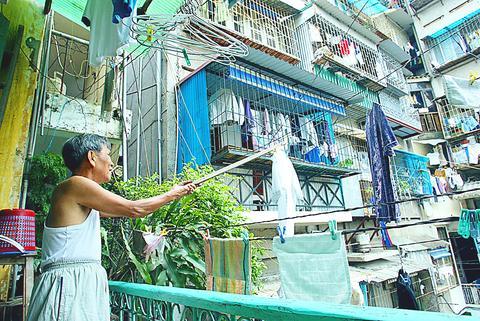Tigers face extinction in the forests of Indochina, but it's easy to find a trace of the big cats in Vietnam's capital, although not in traditional herbal medicine stores.
In fast-expanding communist Vietnam, the "tiger cage" has been helping thousands of residents battle shrinking living spaces.

PHOTO: REUTERS
For decades, ingenious dwellers in cramped apartments have built frames of steel bars, dubbed tiger cages, to transform balconies or common corridors into spaces where they can cook, sleep, dry clothes, raise pigs or do a spot of gardening.

PHOTO: REUTERS
Historically, tiger cages have had a notorious connotation, as slang referring to French prison cells built by Vietnam's former colonial master in the early 1860s to house nationalist insurgents.
But these days the term tiger cages has a happier meaning.

PHOTO: REUTERS
"It gives freedom to a family within that space," said Nguyen Duc Hoan, 36, who lived from 1992 to 2001 in a 32m2 fifth-floor flat with his wife.
The housing innovation is a common sight at state-built apartments in Ho Chi Minh City, Hanoi, Haiphong and Danang, Vietnam's four largest cities and home to nearly 14 million of the Southeast Asian nation's total population of 81 million.
A recent survey in the four cities by the Construction Ministry reveals that each resident is confined to an average living area of 3m2 to 6m2.
SAFE PLAYGROUND
Hoan, who is a private steel trader, said the tiger cage's steel frame, though not constructed according to any code, helps deter break-ins and creates a safe playground above the bustling streets for children, including his son.
"The security reason is the primary goal as doors and windows are all wooden," he said. "People never thought of it as an architectural solution."
Hanoi built its first four-story residential buildings in the late 1950s, initially for state employees. The tiger cage emerged only when the next generation moved in.
In the next 20 years, buildings made from concrete panels sprung up, often with eight families on a floor sharing two pairs of communal toilets and kitchens, an influence of communist allies the Soviet Union and North Korea.
Now the several-decades-old 430 buildings in Hanoi are home to more than 137,000 people but are no longer an ideal accommodation or a sought-after state reward.
Half of them are slum houses with narrow corridors and stairways, low ceilings and leaking pipes. Coal-fired stoves and a lack of parking add to the difficult conditions.
"The daily living is very inconvenient, as many generations share the same one space," Hoan said.
But it isn't easy to upgrade.
"Not everyone can afford to buy a larger place," said a Vietnamese economist who has been living in a 60m2 flat in the past five years in Hanoi.
Hanoi's housing department said 22 of the 430 old buildings must be demolished and another 267 needed urgent repair.
Some who have managed to escape the confining spaces are grateful.
STILL A DREAM
In 2001, Hoan moved to a new house, with a small yard.
"The first feeling is about the freedom, as I can hang out late and come home any time I like and I don't have to push my motorbike all the way up to the fifth floor," he said.
In the old days, an elderly woman who managed the car park at his apartment building locked it up and went to bed at 10pm.
The government controls 21.3 million m2 of residential space, or just 2.9
percent of Vietnam's total, and is unable to pay for the upkeep.
Hoan said his place was repainted just once in nine years.
Yet a flat remains the goal for middle-class people and migrants moving in from the countryside, with monthly rentals ranging between 600,000 dong and 2 million dong (US$38 to US$127).
"It's still a dream for many people to have," said the economist. Per capita income is US$400 a year in Vietnam.
Hoan's fifth-floor flat was sold for 400 million dong (US$25,445), a sum that takes 66 years for state employees on a monthly income of 1.5 million dong (US$95) to accumulate -- provided they can save 500,000 dong each month.
Speculation has been driving up prices on anything from old government-built flats to swanky condominiums.
The government has set an ambitious goal of raising the average living area to 15m2 per person by 2010, with different types of homes to match varying tastes.
As new condominiums are built to replace the old-fashioned flats, new owners vow to hang onto their extra space as long as their families grow.
But the economist said the tiger cage would only become extinct once security of flats was assured.
"The steel bars will still exist for protection," Hoan said. "There would still be a modified tiger cage."

Taiwanese chip-making giant Taiwan Semiconductor Manufacturing Co (TSMC) plans to invest a whopping US$100 billion in the US, after US President Donald Trump threatened to slap tariffs on overseas-made chips. TSMC is the world’s biggest maker of the critical technology that has become the lifeblood of the global economy. This week’s announcement takes the total amount TSMC has pledged to invest in the US to US$165 billion, which the company says is the “largest single foreign direct investment in US history.” It follows Trump’s accusations that Taiwan stole the US chip industry and his threats to impose tariffs of up to 100 percent

On a hillside overlooking Taichung are the remains of a village that never was. Half-formed houses abandoned by investors are slowly succumbing to the elements. Empty, save for the occasional explorer. Taiwan is full of these places. Factories, malls, hospitals, amusement parks, breweries, housing — all facing an unplanned but inevitable obsolescence. Urbex, short for urban exploration, is the practice of exploring and often photographing abandoned and derelict buildings. Many urban explorers choose not to disclose the locations of the sites, as a way of preserving the structures and preventing vandalism or looting. For artist and professor at NTNU and Taipei

In the run-up to World War II, Admiral Wilhelm Canaris, head of Abwehr, Nazi Germany’s military intelligence service, began to fear that Hitler would launch a war Germany could not win. Deeply disappointed by the sell-out of the Munich Agreement in 1938, Canaris conducted several clandestine operations that were aimed at getting the UK to wake up, invest in defense and actively support the nations Hitler planned to invade. For example, the “Dutch war scare” of January 1939 saw fake intelligence leaked to the British that suggested that Germany was planning to invade the Netherlands in February and acquire airfields

The launch of DeepSeek-R1 AI by Hangzhou-based High-Flyer and subsequent impact reveals a lot about the state of the People’s Republic of China (PRC) today, both good and bad. It touches on the state of Chinese technology, innovation, intellectual property theft, sanctions busting smuggling, propaganda, geopolitics and as with everything in China, the power politics of the Chinese Communist Party (CCP). PLEASING XI JINPING DeepSeek’s creation is almost certainly no accident. In 2015 CCP Secretary General Xi Jinping (習近平) launched his Made in China 2025 program intended to move China away from low-end manufacturing into an innovative technological powerhouse, with Artificial Intelligence